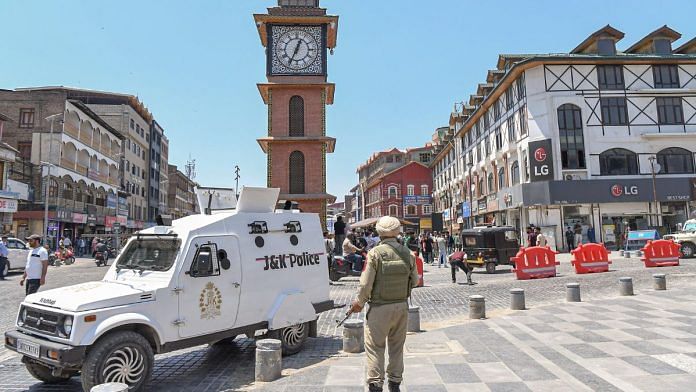For generations, Indian strategists who unleashed them acted in the belief that the Generals across the border were much like themselves—rational actors who respond predictably to pain. Yet, as ThePrint’s Editor-in-Chief, Shekhar Gupta, has observed, India’s past punitive operations have brought only short-lived in Kashmir. This is an outcome well short of meaningful deterrence.
Like his predecessors, Pakistan Army Chief General Asim Munir is the custodian of a praetorian ideological state built around the Islamist credo called the Ideology of Pakistan. “Three wars have been fought for Kashmir, and if ten more need to be fought, we will fight, Allah willing,” General Munir earlier this year. “Allah’s group will always prevail based on faith, piety, and jihad. Endless war with India is not a means to an end; it is the end that allows the state to survive.
Fragility has been the essence of Pakistan’s condition since its birth. Liaquat Ali Khan, the country’s first prime minister, announced in a 1948 broadcast that defence must “dominate all other government activities.” For years after Independence, historian Paul M McGarr, defence expenditure made up more than 70 per cent of Pakistan’s budget. Former president Mohammad Ayub Khan likewise that the survival of the country “was vitally linked with the establishment of a well-trained, well-equipped and well-led army.”
From the Kashmir war of 1947-1948, the Nizam’s defeat in Hyderabad and their failure to secure Junagarh, Pakistan’s strategic elite learned a perverse lesson: The answer to its weakness was not rapprochement, but the prosecution of a relentless programme to bleed its eastern neighbour.
Only a week has passed since the 100-hour war, making it difficult to draw useful conclusions. For its part, independent analysis suggests that India lost at least two fighter jets, and perhaps as many as five, in the opening hours of the combat, including a Rafale, a Sukhoi-30, and a MiG-29. Forewarned by India that it would strike at targets alone, French analyst Fabrice Wolf has suggested the Pakistan Air Force responded by using long-range missiles to target aircraft that remained on the Indian side of the border.
Following this first phase of combat, India’s defences successfully beat back waves of drone attacks, and then hit at least six high-value airfields in Pakistan with precision missiles, satellite imagery shows—attacks significant not for the damage they caused, but for demonstrating the ability to cripple military infrastructure deep inside Pakistan.
To measure the impacts of this crisis simply by weighing the material damage is a futile exercise. As the Soviet General Andrian Danilevich said, “If the military art could be reduced to arithmetic, we would not need any wars.” The Generals have proved willing to absorb damage and move on.
From the past, it’s clear just how tenuous the gains from Indian coercion have proved. The victory in Kargil saw a sharp escalation of violence in Kashmir, which claimed than were lost in the war. The 2001-2002 crisis might have engendered a peace process, but it led to 26/11 and the uprisings of 2006, 2010, 2012, and 2016. The cross-Line of Control strikes of 2016 drew retaliation in the form of multiple Fidayeen attacks; the 2019 Balakot strike did nothing to end attacks on Indian troops.
This raises a simple question: What, then, might deter Pakistan?
The problem of how to deter Pakistan from using its resources to support terrorist groups, it’s useful to remember, is neither new, nor unique to India. Faced with the growing flow of weapons and personnel into Afghanistan, Central Intelligence Agency documents show that the Soviet Union stepped up air strikes against both mujahideen and the Pakistan Army border outposts in 1985-1986. The first six months of 1986, the CIA recorded, saw Soviet air incursions into Pakistan rise to about 500—doubling from the same period the previous year.
Even though the United States supplied state-of-the-art surface-to-air missiles to build up Pakistan’s air defences, Soviet pilots proved skilled at evading threats. From mid-1985 onward, Islamabad’s Stinger, Redeye, and Crotale missile systems succeeded in regularly claiming kills. The country credits its F-16s with bringing down 10 Soviet aircraft; however, the Soviet archives confirm the loss of three Su-22s, a Su-25, and an An-26 transport.
Authors Lester W Grau and Ali Ahmad Jalali have recorded that Soviet special forces also took the battle into Pakistan, destroying mujahideen bases in Zahawar to disrupt the jihadist supply line from Miranshah. The cave complex at Zahawar was overrun in April 1986. The Spetsnaz, or Soviet special forces, across the Kunar River in Krer. The famous battle for Hill 3234 saw just 39 Soviet paratroopers of the 345 Independent Guards hold off by mujahideen and Pakistani special forces for several days in 1988.
To increase pressure, the Afghan intelligence service Khadamat-e Etalaat-e Dawlati, or KhAD, stepped up a inside Pakistan. The at a Pakistan International Airlines office in 1986 was intended to signal that the Soviet Union was willing to inflict pain across the border. This was cheaper than air strikes, though less damaging to mujahideen infrastructure.
The KhAD also manipulated clan and ethnic grievances and allied with figures like the narcotics trafficker Wali Khan Kukikhel to turn groups like the Afridi against the ISI. These enterprises have fleeting results, with the tribes frequently switching sides, but they did take the conflict south of the Afghan border into Khyber Pakhtunkhwa.
This long campaign of attrition, though, proved inadequate to end Pakistan’s backing for the mujahideen, underwritten by the West. Long before it began pulling troops back across the Amu Darya river, it had become clear to the Soviets that the costs of the campaign far outweighed Afghanistan’s strategic significance.
Like America would, in turn, be taught, the Soviets learned a lesson: in long ideological wars, the patient wins, not the victorious.
Even as Indian strategists consider how to deter the next terrorist strikes, there are urgent challenges within Kashmir. Like it or not, the Pakistan Army has shown it is willing to fight. This has given renewed hope to the pro-Pakistan constituency within Kashmir. To win this battle, India needs a sharply focused strategy to strengthen the legitimacy of the political system. Even more importantly, New Delhi needs to address the deep fears of Hindu communalism that still runs through Kashmir’s cultural consciousness.
The government also needs to engage with the atrophy that has seized policing in Jammu and Kashmir. Four of six ethnic Kashmiri terrorists had been active in the region for years, highlighting the diminished flow of local intelligence. That, in turn, is linked to issues of training, morale, and leadership, rooted in the poorly conceived decision to the Jammu and Kashmir Police cadre in 2019.
Finally, India needs to rein in its own impulses for knee-jerk violence, manifested in the demolitions of homes and unfocussed arrests after Pahalgam. India has worn down the insurgency in Jammu and Kashmir to. Last year, despite multiple ambushes targeting the Indian Army, only 26 security force personnel were killed—the lowest level since 2012. Fatalities of civilians were at their lowest level in a quarter-century.
True, Pakistan retains the capacity to stage politically damaging attacks like Pahalgam and even unleash terrorist bombings against Indian cities—but India has choices about how to respond. Though punishing terrorists and their sponsors is important, India should remember its endgame is winning Kashmir, not fighting Pakistan.
(Edited by Aamaan Alam Khan)








